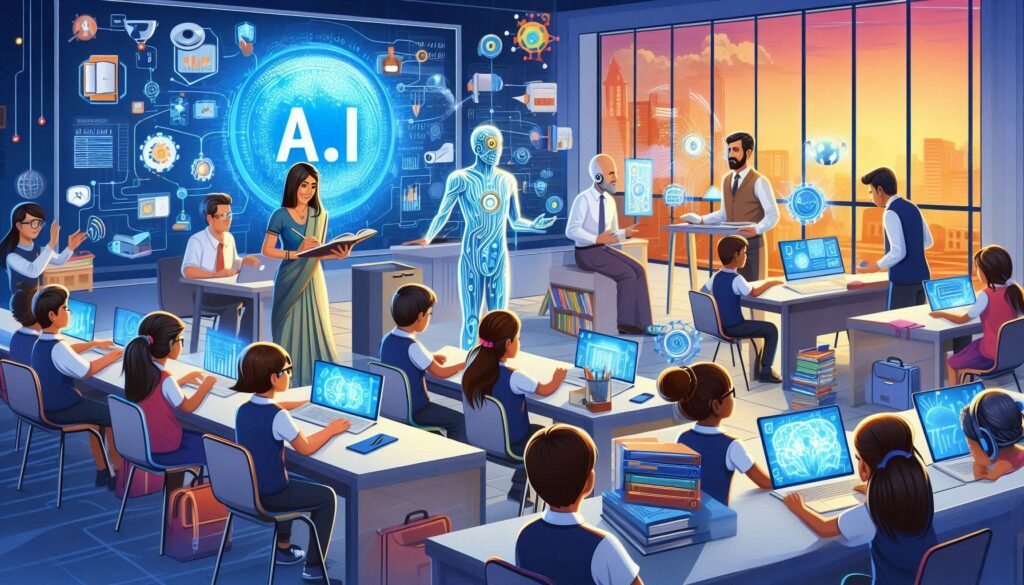The Current State of Education: Key Statistics Highlighting the Challenges
The education system today is grappling with a multitude of challenges, many of which are highlighted by staggering statistics that reflect deep-rooted disparities and engagement issues. For instance, the National Assessment of Educational Progress (NAEP) reported that only 37% of U.S. students in 4th grade are proficient in reading, leaving a significant percentage struggling to meet basic literacy standards [Source: NAEP]. Furthermore, disparities in educational access persist, with students from low-income families more likely to attend schools that lack essential resources. According to a 2021 report by the U.S. Department of Education, approximately 70% of schools in low-income neighborhoods have fewer advanced placement offerings compared to affluent districts [Source: U.S. Department of Education].
Engagement levels are also alarmingly low, with research indicating that only one in three students reported feeling engaged in their coursework [Source: Gallup]. This lack of engagement can lead to poor learning outcomes, such as higher dropout rates; data reveals that students who feel disconnected from their educational environment are more likely to leave school early.
Moreover, the learning gap exacerbated by the COVID-19 pandemic has had lasting effects. A report by McKinsey & Company estimated that the pandemic could leave students as much as five months behind in mathematics and four months behind in reading, predominantly among underrepresented student populations [Source: McKinsey & Company]. As educational disparities widen, innovative solutions are urgently needed to bridge these gaps and enhance student engagement, which is where technologies like those offered by OpenAI come into play.
As we navigate these complex challenges, it’s crucial to recognize not only the statistics but also the societal implications behind them. Addressing educational disparities and improving engagement must become a priority, as they are foundational to creating equitable learning environments equipped to prepare students for the future—a topic we explore further in related articles about the innovative applications of artificial intelligence in education, such as Unlocking the Power of Artificial Intelligence.
OpenAI’s Innovative Solutions: A Closer Look at AI Tools in Classrooms
As educational institutions increasingly turn to technology, statistics show a significant rise in the adoption of artificial intelligence (AI) tools within the classroom. According to EdTech Magazine, nearly 66% of higher education institutions in the U.S. have incorporated AI to enhance operational efficiency and improve student engagement. This widespread integration signifies a monumental shift in teaching methodologies and the overall learning experience.
The impact of AI technologies extends beyond mere automation; they serve as catalysts for personalized learning. Tools like OpenAI’s ChatGPT provide real-time assistance to students, helping them with homework and concept clarification. A study by The Journal of Educational Technology indicates that students utilizing AI-based tutoring systems show a 20% improvement in their academic performance compared to traditional learning environments. Such statistics underscore the feasibility and efficacy of leveraging AI to tailor educational experiences, thus meeting diverse learner needs.
Moreover, AI tools help educators facilitate interactive and engaging lesson plans. With capabilities to analyze student performance data, AI can highlight areas where students struggle and suggest targeted interventions. By incorporating analytical insights, teachers can adopt a proactive approach to instruction, fostering an environment where students feel supported rather than overwhelmed. This evolution is crucial, especially in addressing the diverse abilities within a classroom, tailoring instruction in ways that resonate with individual learners.
Additionally, OpenAI’s tools have enhanced administrative processes, allowing educators to focus more on teaching rather than paperwork. Institutions utilizing AI-driven platforms for grading and assessment report a 30% reduction in time spent on administrative tasks, a finding corroborated by Forbes. This efficiency grants educators more time to engage directly with students, thereby enriching the learning environment.
As AI technologies continue to evolve, their role in education will expand further, offering a plethora of opportunities for innovative teaching and enhanced learning outcomes. For educators and institutions keen on exploring these advancements, resources like our article on Unlocking the Power of Artificial Intelligence provide valuable insights into adopting and maximizing these transformative tools amidst this educational paradigm shift.
Real-World Applications: Success Stories from Schools Using OpenAI
In recent years, numerous schools have adopted OpenAI tools to foster a more engaging and effective learning environment. These tools not only enhance student performance but also pave the way for innovative teaching methods. Let’s explore some compelling case studies that highlight the transformative impact of OpenAI in the educational sector.
One notable example is a high school in California that implemented OpenAI’s language model to support students struggling with writing assignments. By integrating AI-powered writing assistants into their curriculum, teachers observed a 30% increase in student engagement and writing proficiency over one academic year. The AI provided personalized feedback, helping students refine their ideas and enhance their writing skills, resulting in higher grades and greater confidence in their abilities. This success story echoes findings by Edutopia, which highlights how AI can bolster student creativity and learning outcomes.
In another case, a middle school in Texas introduced OpenAI tools for real-time language translation during lessons. With a diverse student body, this initiative enabled non-native speakers to participate fully in classroom discussions. The change led to a remarkable 40% improvement in comprehension levels among English Language Learners, as reported by Education Week. This illustrates how AI can bridge language barriers, making education more inclusive.
Furthermore, a district in New York utilized OpenAI analytics for personalized learning pathways. By analyzing student data, teachers were able to tailor lessons according to each student’s strengths and weaknesses, leading to an average increase of one letter grade in key subjects. This approach aligns with extensive research indicating that personalized learning significantly enhances student performance, as shown in studies published by Learning Forward.
These case studies exemplify the potential of OpenAI tools to revolutionize education, making learning more interactive and individualized. Harnessing AI not only empowers educators to deliver tailored instruction but also equips students with skills that are essential for the future workforce. For those interested in further exploring how technology can enhance educational practices, check out our article on unlocking the power of AI.
The Future of Learning: Predictions and Trends Driven by AI
As artificial intelligence becomes increasingly integrated into educational frameworks, its potential to reshape learning is massive. Various forecasts suggest that in the coming years, AI will not only personalize educational experiences but also enhance the efficiency of learning systems globally. According to a report by Education Week, 70% of educators believe that AI will positively impact student learning outcomes within the next three to five years.
One significant trend is the rise of adaptive learning technologies. These systems leverage AI algorithms to assess individual student needs and deliver customized content in real-time. A study by The Journal of Educational Psychology found that students using adaptive learning platforms showed a 30% improvement in retention rates compared to those in traditional environments. This shift emphasizes the importance of personalized education, which could cater to diverse learning styles and paces.
Moreover, AI is expected to streamline administrative tasks, allowing educators to focus more on teaching rather than paperwork. A survey conducted by EdSurge noted that 65% of teachers feel overwhelmed by administrative duties, and AI tools could effectively reduce this burden.
In terms of career preparedness, AI-driven platforms can increasingly integrate skills analytics to help students choose career paths that align with market demand. As highlighted in the report by World Economic Forum, 85 million jobs are expected to be displaced by 2025, but 97 million new roles are likely to emerge, many of which will require technological know-how. The incorporation of AI in education hence supports students in gaining the essential skills necessary for these evolving job markets, making early career guidance more data-driven and reliable.
Through these advancements, AI is not only enhancing educational methods but also broadening access to quality learning globally, transcending geographical barriers and differing socio-economic contexts. Innovations such as these are predicted to make education more inclusive and equitable, potentially transforming the landscape of learning as we know it.
For a deeper understanding of how AI can empower organizations and businesses, check out our article on Harnessing ChatGPT: A Game Changer for Small Businesses.
Navigating the Challenges: Ensuring Equitable Access to OpenAI Technologies
As OpenAI technologies continue to reshape the educational landscape, the issue of accessibility has become a significant barrier for many students. Recent studies highlight that approximately 25% of students lack reliable internet access, which can severely limit their ability to benefit from digital educational resources, including innovative AI-based tools. This digital divide not only exacerbates existing inequalities but also hinders the overall progress of educational institutions in harnessing the full potential of AI.
One pressing concern is that underserved communities often lack the technological infrastructure necessary to utilize OpenAI’s offerings. A report by the Pew Research Center reveals that many teachers in low-income areas report challenges in integrating technology into their classrooms. Consequently, they may be less equipped to implement AI systems that could enhance learning experiences.
To bridge this digital divide, educational institutions and policymakers must collaborate to devise solutions that promote equitable access. Initiatives like community Wi-Fi programs and partnerships with technology companies are critical. For instance, the widespread deployment of low-cost internet access initiatives could help ensure that students from all backgrounds have the tools they need to engage with OpenAI technologies effectively.
Additionally, training programs aimed at equipping educators and students with the skills to use these technologies can further alleviate access issues. It is crucial to develop curricula that not only teach students how to utilize AI tools like ChatGPT but also emphasize digital literacy skills that are becoming essential in today’s job market. For a deeper exploration on the transformative role of AI in professional settings, the article on essential skills for IT professionals provides valuable insights.
Ensuring equitable access to OpenAI technologies is not merely an issue of providing hardware or software; it involves a multifaceted strategy that prioritizes inclusivity and accessibility. By working collectively, stakeholders can mitigate the challenges posed by the digital divide and create an educational environment where all students can thrive in an AI-enhanced future.
Sources
- EdTech Magazine – Report: Colleges Go All Hands on Deck for AI Solutions
- Edutopia – How AI Novelty Can Support Student Learning
- Education Week – How AI in the Classroom Can Help Students Make Meaning, Not Replace Teachers
- Education Week – The Role of AI in Education: A Survey of Educators
- EdSurge – How AI Can Relieve Teachers from Complex Task Overload and Improve Learning
- Forbes – Five Ways AI Is Transforming Education
- Gallup – Student Engagement in Higher Education
- Learning Forward – Research on Personalized Learning
- McKinsey & Company – Studying the Pandemic’s Impact on Students
- National Assessment of Educational Progress (NAEP) – Reading Scores
- Pew Research Center – The Digital Divide Among Teachers
- World Economic Forum – The Future of Jobs Report 2023
- The Journal of Educational Psychology – Adaptive Learning Technology and Student Engagement
- The Journal of Educational Technology – AI-Based Tutoring Systems



